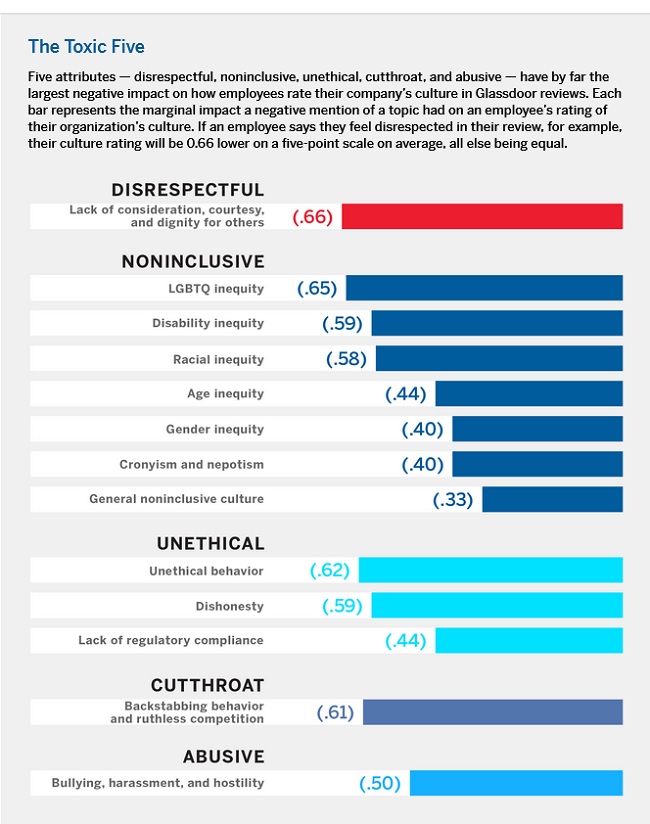Common Management Errors (3 cont. fi) A Toxic Culture Caused by Mishandling Change
Introduction
When employees join an organisation
"...they expect to find a culture that is inclusive, respectful, ethical, collaborative, and free from abuse by those in positions of power. Not only are these baseline elements of a healthy corporate culture, they are also what companies typically promise..."
Donald Sull et al, 2022
Research (USA) has shown the following values are most mentioned by organisations - integrity, collaboration, respect, diversity and inclusion.
As change can challenge the organisational norms, mindsets, status quo, etc, unless the process is handled correctly. This can be confronting for staff and could create the basis for a toxic culture.
Furthermore, toxic culture is one of the main reasons staff disengaged, 'badmouth' their employer and even quit the organisation.
"...Toxic culture......was the single biggest predictor of attrition during the first six months of the Great Resignation - 10 times more powerful than how employees viewed their compensation in predicting employee turnover..."
Donald Sull et al, 2022
Many elements of organisational culture can be annoying, disappointing and irritating, like risk adversity, excessively bureaucratic, impersonal, favouritism, status quo focus, not creative, etc but they are not necessarily toxic. Toxicity is more linked with
"...discrimination, abusive managers, unethical organisational behaviour, workplace injustice and incivility..."
Donald Sull et al, 2022
The language people use to describe their organisation provides a good indication of the organisational culture, eg
- how they refer to minority groups
- words like 'cliques', 'clubby', 'in-crowd', etc indicate that somebody is being excluded or included without specifying why.
Some indications of toxic culture can include
"... - When you hear ambiguous phrases like 'you know, other people don't think you can do this job, but I do' from your manager, it reflects a lack of transparency and tolerance of gossip
- Mistakes are met with eye-rolling commentary in the vein of 'I'm shocked by your cavalier attitude when sending confidential e-mails'
- Rather than respond to a summary of weekly accomplishments with gratitude, you might hear, 'I don't need this princess report, everybody here is working really hard'
- Openly discussing confidential or sensitive information, such as salaries or disclosed mental health challenges, in team settings was cited as an example of what undermines trust
- A reason that toxic culture persists is because it's never addressed..."
John Horn, 2022
Five main toxic attributes
i) disrespect (shown by lack of consideration, courtesy, dismissing alternative points of view)
ii) non-inclusive conduct (refers to treatment based on demographics and/or identity like gender, race, sexual identity, sexual orientation, disability and age; nepotism and favouritism is often on display when there is a motion of people from similar backgrounds rather than the most qualified candidate
iii) unethical behaviour (absence of integrity, ethics; dishonesty, eg lied to, misled, deceived; false promises are given, shady conduct, break your word, etc; failure to comply with applicable laws, rules, regulations, etc )
iv) cut-throat (over-competitive within the organisation, eg with colleagues actively undermining one another; lack of cooperation, collaboration and coordination within the organisation; some terms to use to describe this include
"...'dog-eat-dog', and 'Darwinian' and talk about co-workers who 'throw one another under the bus', 'stab each other in the back' or 'sabotage one another'..."
Donald Sull et al, 2022
v) abusive behaviour (it is sustained hostile behaviour towards staff like
"...bullying, yelling or shouting at employees, belittling or demeaning subordinates, verbally abusing people and condescending or talking down to employees..."
Donald Sull et al, 2022
NB another way of saying the above is
"...discrimination, abusive managers, unethical organisational behaviour, workplace injustice..."
Donald Sull et al, 2022

(source: Donald Sull et al, 2022)
NB Generally research focuses on an organisation in its overall cultural rating based on the average of all employees, ie exclusively measuring corporate culture in aggregate terms. However, this approach might miss elements, such as diversity, equity and inclusion, that are highly significant to a small percentage of the workforce, eg LGBTQ equity.
Costs of toxic culture
"...Toxic atmosphere is associated with elevated levels of stress, burnout, and mental health issues. Toxicity also translates into a physical illness..."
Donald Sull et al, 2022
When somebody experiences injustice in the workplace, there is an increased chance of suffering a major disease like coronary disease, asthma, diabetes and arthritis.
In addition to the personal cost of a toxic culture, there is an organisational impact:
- staff attrition is higher (many employees have left a job because of its culture; replacing a staff member costs the organisation up to twice their annual salary, including direct and indirect expenses)
- less able to attract talent (most US jobseekers only apply to organisations if their personal values are in line with the organisation's values)
- staff are disengaged and less productive (most disengaged staff are looking for alternative jobs; loss from reduced productivity is up to 18% of staff annual salary; around half of staff who experience incivility spend less time at work and decrease their effort)
- higher health care costs (can cost billions of dollars; increased chance of suffering a major health disease)
- higher risk of reputational damage and legal liability (increasing chance of developing to unethical and illegal behaviour; low corporate integrity is associated with lower financial value; with social media it is very hard for an organisation to keep their cultural problems a secret)
NB
"...women, underrepresented minorities, or older employees, for example, might have a more negative view of the culture than other employees. In most large organisations, distinctive micro-cultures coexist within the same company, often across business units, functions, geographies, for acquired companies. Individual leaders also create sub-cultures within the extended teams. Whatever their origin, micro-cultures can diverge from the broader corporate culture, which means that even the best cultures can contain pockets of cultural toxicity..."
Donald Sull et al, 2022
